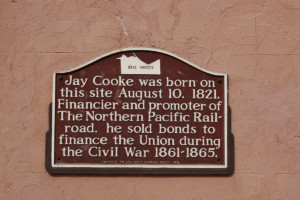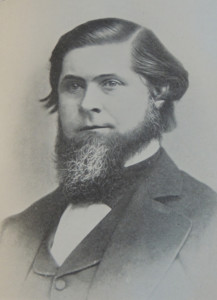 JAY COOKE’S BIRTHPLACE
JAY COOKE’S BIRTHPLACE
A marker on the north side of the old Cooke Building which faces East Market Street once marked the location where Jay Cooke, Civil War financier and developer of the Northern Pacific Railroad was born on August 10, 1821. Cooke’s parents, Eleutheros and Martha Cooke, were in the process of building a home half a block away on Columbus Avenue and Jay Cooke was born in the house of a friend, Dr. George Anderson.
Cooke left Sandusky when he was 18, eventually settling in Philadelphia where he became a successful banker. He founded his own firm in 1861 at the age of 40.
 Arguably the Sandusky native who has had the most impact on our national story, Cooke created a very successful program for selling bonds to help finance the Union war effort during the Civil War. A sales and marketing genius, Cooke introduced sales techniques and strategies that were later adopted for the great war bond drives of the 20th century. He sold bonds utilizing an emotional appeal to a buyer’s patriotism. He also sold bonds in denominations as low as $50, even allowing purchase on the installment plan. These strategies had never before been used to sell financial products.
Arguably the Sandusky native who has had the most impact on our national story, Cooke created a very successful program for selling bonds to help finance the Union war effort during the Civil War. A sales and marketing genius, Cooke introduced sales techniques and strategies that were later adopted for the great war bond drives of the 20th century. He sold bonds utilizing an emotional appeal to a buyer’s patriotism. He also sold bonds in denominations as low as $50, even allowing purchase on the installment plan. These strategies had never before been used to sell financial products.
Cooke’s firm managed over $1.6 billion in bond sales during the Civil War.
Deeply religious, strongly anti-slavery, and a patriot, Jay Cooke was committed to the Union cause but also an astute businessman. In the immediate post-Civil War period, he was probably one of the richest men in America.
In addition to a mansion in Philadelphia, Cooke bought Gibraltar Island in Lake Erie and built a magnificent summer home on the island called Cooke’s Castle. Cooke and his extended family spent 40 summers on Gibraltar, which is now owned by Ohio State University.
Always a believer in the country’s western destiny, in 1870 Cooke’s bank took the lead in financing the Northern Pacific Railway, a railroad line that would run from Duluth, Minnesota to Tacoma, Washington, connecting the Great Lakes to Puget Sound and the Pacific Ocean. There were numerous problems, including conflicts with Sioux Indians, construction and management issues, and low demand for rail services in what was still near wilderness. Cooke’s problems helped precipitate the Panic of 1873, the biggest economic downturn of the 19th century. Cooke was overextended and lost his railroad and his fortune.
However, Cooke did recover much of his resources through investments in a silver mine, but by the mid-1880s he had largely retired from business.
His railroad line, which became the Northern Pacific Railroad, was completed by others and formally opened in 1883.
Cooke died in Philadelphia in 1905 at the age of 84.
